Electricity has become an essential part of our daily lives. From lighting our homes to powering complex machines, it plays a crucial role in modern civilization. In this chapter, we will explore the fundamental concepts of electricity—what it is, how it flows, how we measure it, and how it is applied in various real-life situations.

Understanding electricity is not only important for academic purposes but also vital for developing a scientific perspective on everyday phenomena.
Class 10 Science Ch 12 Electricity – Textbook Page no. 200
Question 1
What does an electric circuit mean ?
Answer:
A continuous and closed path along which an electric current flows is called an electric circuit.
Question 2
Define the unit of current.
Answer:
Unit of current is ampere. If one coulomb of charge flows through any section of a conductor in one second then the current through it is said to be one ampere.
I = 1 A = I C s-1
Question 3
Calculate the number of electrons constituting one coulomb of charge.
Answer:
Given:
Charge of one electron (e) = 1.6 × 10⁻¹⁹ coulombs
Number of electrons (n) = Total charge / Charge of one electron
n = 1 C / (1.6 × 10⁻¹⁹ C)
n = 6.25 × 10¹⁸
Page Number: 202 – Class 10 Science Ch 12 Electricity
Question 1
Name a device that helps to maintain a potential difference across a conductor.
Answer:
A battery.
Question 2
What is meant by saying that the potential difference between two points is IV?
Answer:
The potential difference between two points is said to be 1 volt if 1 joule of work is done in moving 1 coulomb of electric charge from one point to the other.
Question 3
How much energy is given to each coulomb of charge passing through a 6 V battery ?
Answer:
Energy given by battery = charge x potential difference
or W = QV = 1C X 6V = 6J.
Page Number: 209 – Class 10 Science Ch 12 Electricity
Question 1
On what factors does the resistance of a conductor depend ?
OR
List the factors on which the resistance of a conductor in the shape of a wire depends. [CBSE2018]
Answer:
The resistance of a conductor depends
(i) on its length
(ii) on its area of cross-section and
(iii) on the nature of its material.
Question 2
Will current flow more easily through a thick wire or a thin wire of the same material, when connected to the same source ? Why ?
Answer:
The current will flow more easily through a thick wire than a thin wire of the same material. Larger the area of cross-section of a conductor, more is the ease with which the electrons can move through the conductor. Therefore, smaller is the resistance of the conductor.
Question 3
Let the resistance of an electrical component remains constant while the potential difference across the two ends of the component decreases to half of its former value. What change will occur in the current through it?
Answer:
According to Ohm’s Law:
I = V / R
If the resistance remains constant and the potential difference becomes half, then the current will also become half.
Question 4
Why are coils of electric toasters and electric irons are made of an-alloy rather than a pure metal ?
OR
Why are alloys commonly used in electric heating devices? Given reason. [CBSE 2018]
Answer:
The coils of electric toasters, electric irons and other heating devices are made of an alloy rather than a pure metal because (i) the resistivity of an alloy is much higher than that of a pure metal, and (ii) an alloy does not undergo oxidation (or burn) easily even at high temperature, when it is red hot.
Question 5
Use the data in Table 12.2 (in NCERT Book on Page No. 207) to answer the following :
(i) Which among iron and mercury is a better conductor ?
(ii) Which material is the best conductor ?
Answer:
(i) Resistivity of iron = 10.0 x 10-8 Ω m
Resistivity of mercury = 94.0 x 10-8 Ω m.
Thus iron is a better conductor because it has lower resistivity than mercury.
(ii) Because silver has the lowest resistivity (= 1.60 x 10-8 Ω m), therefore silver is the best conductor.
Page Number: 213 – Class 10 Science Ch 12 Electricity
Question 1
Draw a schematic diagram of a circuit consisting of a battery of three cells of 2 V each, a 5Ω resistor, an 8 Ω resistor, and a 12 Ω resistor, and a plug key, all connected in series.
Answer:
The required circuit diagram is shown below :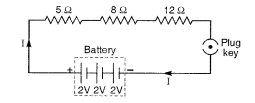
Question 2
Redraw the circuit of Questions 1, putting in an ammeter to measure the current through the resistors and a voltmeter to measure the potential difference across the 12 Ω resistor. What would be the readings in the ammeter and the voltmeter ?
Solution:
The required circuit diagram is shown on the right.
Total voltage, V = 3 x 2 = 6V
Total resistance, R = 5Ω + 8Ω + 12Ω = 25Ω
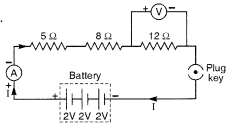
Page Number: 216 – Class 10 Science Ch 12 Electricity
Question 1
Judge the equivalent resistance when the following are connected in parallel :
(i) 1 Ω and 106 Ω,
(if) 1 Ω and 103 Ω and 106 Ω.
Answer:
(i) 1 Ω and 106 Ω
Using the formula for parallel resistors:
1 / Req = 1 / 1 + 1 / 106
1 / Req = (106 + 1) / 106 = 107 / 106
So, Req = 106 / 107 Ω
Answer: 106/107 Ω
(ii) 1 Ω, 103 Ω, and 106 Ω
Using the formula for parallel resistors:
1 / Req = 1 / 1 + 1 / 103 + 1 / 106
First, find a common denominator and add:
1 / Req = (103 × 106 + 106 + 103) / (103 × 106)
= (10918 + 106 + 103) / 10918
= 11127 / 10918
So, Req = 10918 / 11127 Ω
Answer: 10918/11127 Ω
Conclusion:
In both cases, the equivalent resistance is less than 1 Ω. This is always true when resistors are connected in parallel.
Question 2
An electric lamp of 100 Ω, a toaster of resistance 50 Ω, and a water filter of resistance 500 Ω are connected in parallel to a 220 V source. What is the resistance of an electric iron connected to the same source that takes as much current as all three appliances, and what is the current through it ?
Solution:
Step 1: Find current through each appliance using Ohm’s law (I = V/R)
Lamp: I₁ = 220 / 100 = 2.2 A
Toaster: I₂ = 220 / 50 = 4.4 A
Water filter: I₃ = 220 / 500 = 0.44 A
Total current drawn by the three appliances:
I_total = I₁ + I₂ + I₃ = 2.2 + 4.4 + 0.44 = 7.04 A
Step 2: Electric iron takes same current (7.04 A), find its resistance
Using Ohm’s law: R = V / I
R = 220 / 7.04 ≈ 31.25 Ω
Final Answers:
Resistance of the electric iron = 31.25 Ω
Current through the electric iron = 7.04 A
Question 3
What are the advantages of connecting electrical devices in parallel with the battery instead of connecting them in series ?
Answer:
Advantages of connecting electrical devices in parallel with the battery are :
- In parallel circuits, if an electrical appliance stops working due to some defect, then all other appliances keep working normally.
- In parallel circuits, each electrical appliance has its own switch due to which it can be turned on turned off independently, without affecting other appliances.
- In parallel circuits, each electrical appliance gets the same voltage (220 V) as that of the power supply line.
- In the parallel connection of electrical appliances, the overall resistance of the household circuit is reduced due to which the current from the power supply is high.
Question 4
How can three resistors of resistances 2Ω, 3 Ω, and 6Ω be connected to give a total resistance of (i) 4 Ω, (ii) 1 Ω ?
Solution:
(i) We can get a total resistance of 4Ω by connecting the 2Ω resistance in series with the parallel combination of 3Ω and 6Ω.![]()
(ii) We can obtain a total resistance of 1Ω by connecting resistors of 2 Ω, 3 Ω and 6 Ω in parallel.![]()
Question 5
What is (i) the highest, (ii) the lowest total resistance that can be secured by combinations of four coils of resistance 4 Ω, 8 Ω, 12 Ω, 24 Ω?
Solution:
(i) Highest resistance can be obtained by connecting the four coils in series.
Then, R = 4Ω + 8Ω + 12Ω + 24Ω = 48Ω
(ii) Lowest resistance can be obtained by connecting the four coils in parallel.![]()
Page Number: 218 – Class 10 Science Ch 12 Electricity
Question 1
Why does the cord of an electric heater not glow while the heating element does ?
Solution:
Heat generated in a circuit is given by I2R t. The heating element of an electric heater made of nichrome glows because it becomes red-hot due to the large amount of heat produced on passing current because of its high resistance, but the cord of the electric heater made of copper does not glow because negligible heat is produced in it by passing current because of its extremely low resistance.
Question 2
Compute the heat generated while transferring 96000 coulomb of charge in one hour through a potential difference of 50 V.
Solution:
Here, Q = 96,000 C,
t =1 hour = 1 x 60 x 60 sec = 3,600 s,
V = 50 V
Heat generated, H = VQ
= 50Vx 96,000 C
= 48,00,000 J
= 4.8 x 106 J
Question 3
An electric iron of resistance 20Ω takes a current of 5 A. Calculate the heat developed in 30 s.
Solution:
Here, R = 20 Ω, i = 5 A, t = 3s
Heat developed, H = I2 R t = 25 x 20 x 30 = 15,000 J = 1.5 x 104 J
Page Number: 220 – Class 10 Science Ch 12 Electricity
Question 1
What determines the rate at which energy is delivered by a current ?
Answer:
Resistance of the circuit determines the rate at which energy is delivered by a current.
Question 2
An electric motor takes 5 A from a 220 V line. Determine the power of the motor and the energy consumed in 2 h.
Answer:
Here, I = 5 A, V = 220 V, t = 2h = 7,200 s
Power, P = V I = 220 x 5 = 1100 W
Energy consumed = P x t = 100 W x 7200 s = 7,20,000 J = 7.2 x 105 J
Class 10 Science Ch 12 Electricity – Exercise Questions
Question 1
A piece of wire of resistance R is cut into five equal parts. These parts are then connected in parallel. If the equivalent resistance of this combination is R’, then the ratio R/R’ is :
(c) 5
(d) 25
Answer:
(d) 25
Step 1:
When a wire of resistance R is cut into 5 equal parts, each part has resistance = R / 5
Step 2:
Now, all 5 pieces (each of R/5) are connected in parallel.
For equal resistors in parallel, equivalent resistance R’ = (resistance of one) / (number of resistors)
So,
R’ = (R / 5) / 5 = R / 25
Step 3:
Now, find the ratio R / R’
R / R’ = R / (R / 25) = 25
Final Answer: 25 (Option d)
Question 2
Which of the following terms does not represent electrical power in a circuit?
(a) I2R
(b) IR2
(c) VI
Answer:
(b) IR2
Question 3
An electric bulb is rated 220 V and 100 W. When it is operated on 110 V, the power consumed will be :
(a) 100 W
(b) 75 W
(c) 50 W
(d) 25 W
Answer:
(d) 25 W
Step 1:
Find the resistance of the bulb using the formula:
R = V² / P = 220² / 100 = 48400 / 100 = 484 ohms
Step 2:
Now find the power consumed at 110 V:
P = V² / R = 110² / 484 = 12100 / 484 = 25 W
Question 4
Two conducting wires of the same material and of equal lengths and equal diameters are first connected in series and then parallel in a circuit across the same potential difference. The ratio of heat produced in series and parallel combinations would be :
(a) 1 : 2
(b) 2 : 1
(c) 1 : 4
(d) 4 : 1
Answer:
(c) 1 : 4
Let resistance of each wire = R
In series: total resistance = 2R
In parallel: total resistance = R/2
Heat produced (H) = V² / R × t
Let V and t be the same in both cases
Heat in series = V² / (2R)
Heat in parallel = V² / (R/2) = 2V² / R
Ratio of heat in series to parallel = (V² / 2R) ÷ (2V² / R) = 1 / 4
Question 5
How is a voltmeter connected in the circuit to measure the potential difference between two points ?
Answer:
A voltmeter is connected in parallel to measure the potential difference between two points.
Question 6
A copper wire has diameter 0.5 mm and resistivity of 1.6 x 10-8 Ω m. What will be the length of this wire to make its resistance 10 Ω ? How much does the resistance change if the diameter is doubled ?
Answer:
Given:
Diameter = 0.5 mm = 0.0005 m
Radius = 0.00025 m
Resistivity (ρ) = 1.6 × 10⁻⁸ Ω·m
Resistance (R) = 10 Ω
Step 1:
Area (A) = π × r² = π × (0.00025)² = 1.9635 × 10⁻⁷ m²
Use formula: R = ρ × L / A
10 = (1.6 × 10⁻⁸) × L / (1.9635 × 10⁻⁷)
L = (10 × 1.9635 × 10⁻⁷) / (1.6 × 10⁻⁸) = 122.7 m
Length of wire = 122.7 m
Step 2: When diameter is doubled
New diameter = 1.0 mm → new radius = 0.0005 m
New area = π × (0.0005)² = 7.854 × 10⁻⁷ m²
Now, R = (1.6 × 10⁻⁸ × 122.7) / (7.854 × 10⁻⁷) = 2.5 Ω
Final Answer:
Length of wire = 122.7 m
New resistance when diameter is doubled = 2.5 Ω
Second part:
Resistance is given by the formula:
R = ρ × L / A
Where:
R = resistance
ρ = resistivity
L = length of wire
A = cross-sectional area of the wire
The area A of a wire is proportional to the square of the diameter (A = π × (d/2)² = πd² / 4)
So, if the diameter is doubled:
New diameter = 2d
New area = π × (2d/2)² = πd² = 4 × original area
Since resistance is inversely proportional to area, the new resistance becomes:
New R = Original R / 4
Therefore, when the diameter is doubled, the resistance becomes one-fourth.
Question 7
The values of current I flowing in a given resistor for the corresponding values of potential difference V across the resistor are given below :
Plot a graph between V and I and calculate the resistance of the resistor.
Solution:
The graph between V and I for the above data is given below.
The slope of the graph will give the value of resistance.
Let us consider two points P and Q on the graph.
and from P along Y-axis, which meet at point R.
Now, QR = 10.2V – 34V = 6.8V
And PR = 3 – 1 = 2 ampere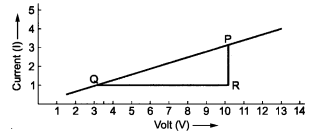
![]()
Thus, resistance, R = 3.4 Ω
Question 8
When a 12 V battery is connected across an unknown resistor, there is a current of 2.5 mA in the circuit. Find the value of the resistance of the resistor.
Solution:
Given:
Voltage (V) = 12 V
Current (I) = 2.5 mA = 2.5 × 10⁻³ A
Using Ohm’s Law:
R = V / I
R = 12 / (2.5 × 10⁻³) = 12 / 0.0025 = 4800 ohms
Final Answer: 4800 ohms or 4.8 kΩ
Question 9
A battery of 9V is connected in series with resistors of 0.2 O, 0.3 O, 0.4 Q, 0.5 Q and 12 £1, respectively. How much current would flow through the 12 Q resistor?
Solution:
Step 1:
Total resistance in series:
R = 0.2 + 0.3 + 0.4 + 0.5 + 12 = 13.4 Ω
Step 2:
Use Ohm’s Law to find current:
I = V / R = 9 / 13.4 ≈ 0.6716 A
Step 3:
In a series circuit, the same current flows through all resistors.
Final Answer:
Current through the 12 Ω resistor = 0.6716 A
Question 10
How many 176 Ω resistors (in parallel) are required to carry 5 A on a 220 V line? [CBSE (Delhi) 2013]
Solution:
Suppose n resistors of 176 Ω are connected in parallel.
Thus 4 resistors are needed to be connect.
Question 11
Show how you would connect three resistors, each of resistance 6 Ω, so that the combination has a resistance of (i) 9 Ω, (ii) 4Ω
Solution:
Here, R1 = R2 = R3 = 6 Ω.
(i) When we connect R1 in series with the parallel combination of R2 and R3 as shown in Fig. (a).
The equivalent resistance is
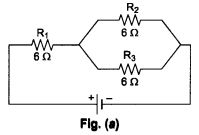
(ii) When we connect a series combination of R1 and R2 in parallel with R3, as shown in Fig. (b), the equivalent resistance is![]()
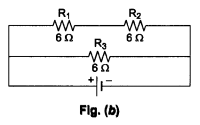
Question 12
Several electric bulbs designed to be used on a 220 V electric supply line, are rated 10 W. How many lamps can be connected in parallel with each other across the two wires of 220 V line if the maximum allowable current is 5 A ?
Solution:
Given:
Voltage (V) = 220 V
Power of each bulb (P) = 10 W
Maximum allowable current (I) = 5 A
Step 1: Find the current drawn by one bulb
Use the formula:
Current, I = P / V
For one bulb:
I₁ = 10 / 220 = 0.04545 A (approx)
Step 2: Let the number of bulbs be n
Total current drawn = n × current of one bulb
So,
n × 0.04545 = 5
Now solve for n:
n = 5 / 0.04545 ≈ 110
Final Answer:
110 bulbs can be connected in parallel.
Question 13
A hot plate of an electric oven connected to a 220 V line has two resistance coils A and B, each of 24 Ω resistance, which may be used separately, in series, or in parallel. What are the currents in the three cases ?
Solution:
(i) When the two coils A and B are used separately. R = 24 Ω, V = 220 V![]()
(ii) When the two coils are connected in series,
(iii) When the two coils are connected in parallel.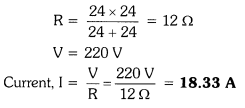
Question 14
Compare the power used in the 2 Ω resistor in each of the following circuits
(i) a 6 V battery in series with 1 Ω and 2 Ω resistors, and
(ii) a 4 V battery in parallel with 12 Ω and 2 Ω resistors.
Solution:
(i) The circuit diagram is shown in figure.
Total resistance, R = 1Ω + 2Ω = 3Ω
Potential difference, V = 6 V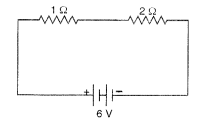
Power used in 2Ω resistor = I2R = (2)2 x 2 = 8 W
(ii) The circuit diagram for this case is shown :
Power used in 2 resistor = [Math Processing Error] =[Math Processing Error] = 8 W.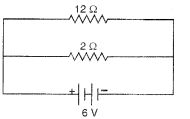
[ ∵ Current is different for different resistors in parallel combination.]
Question 15
Two lamps, one rated 100 W at 220 V, and the other 60 W at 220 V, are connected in parallel to electric mains supply. What current is drawn from the line if the supply voltage is 220 V ? [CBSE 2018]
Solution:
Power of first lamp (P1) = 100 W
Potential difference (V) = 220 V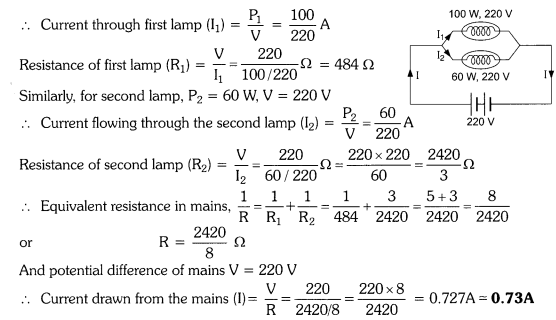
Question 16
Which uses more energy, a 250 W TV set in 1 hr, or a 1200 W toaster in 10 minutes ?
Solution:
Given:
Power of TV = 250 W
Time used = 1 hour = 60 minutes = 3600 seconds
Power of toaster = 1200 W
Time used = 10 minutes = 600 seconds
Step 1: Use the formula for energy consumed
Energy = Power × Time
(Use time in seconds or convert everything to watt-hours for simplicity)
Let’s use watt-hours:
TV energy consumption:
= 250 W × 1 hour = 250 Wh
Toaster energy consumption:
= 1200 W × (10/60) hour = 1200 × 1/6 = 200 Wh
Step 2: Compare the two
TV uses 250 Wh
Toaster uses 200 Wh
Final Answer:
The 250 W TV set in 1 hour uses more energy than the 1200 W toaster used for 10 minutes.
Question 17
An electric heater of resistance 8 Ω draws 15 A from the service mains 2 hours. Calculate the rate at which heat is developed in the heater.
Solution:
Here, R = 8 Ω, 1 = 15 A, t = 2 h
The rate at which heat is developed in the heater is equal to the power.
Therefore, P = I2 R = (15)2 x 8 = 1800 Js-1
Question 18
Explain the following:
(i) Why is tungsten used almost exclusively for filament of electric lamps ?
(ii) Why are the conductors of electric heating devices, such as bread-toasters and electric irons, made of an alloy rather than a pure metal ?
(in) Why is the series arrangement not used for domestic circuits ?
(iv) How does the resistance of a wire vary with its area of cross-section ?
(v) Why are copper and aluminium wires usually employed for electricity transmission?
Answer:
(i) Why is tungsten used almost exclusively for filament of electric lamps?
Tungsten is used because it has a very high melting point (around 3380°C) and can glow at high temperatures without melting. It also has good electrical resistance, which makes it suitable for producing light when electric current passes through it.
(ii) Why are the conductors of electric heating devices, such as bread-toasters and electric irons, made of an alloy rather than a pure metal?
Alloys have higher resistance than pure metals and do not melt easily at high temperatures. They also do not oxidize (burn) easily when heated. This makes alloys more suitable for heating devices.
(iii) Why is the series arrangement not used for domestic circuits?
In a series arrangement, if one appliance stops working or is turned off, the entire circuit breaks and all other appliances stop working too. Also, all appliances get the same current, which may not be suitable. That’s why domestic circuits use parallel arrangements.
(iv) How does the resistance of a wire vary with its area of cross-section?
Resistance is inversely proportional to the area of cross-section.
If the area increases, resistance decreases. If the area decreases, resistance increases.
(v) Why are copper and aluminium wires usually employed for electricity transmission?
Copper and aluminium are good conductors of electricity. They have low resistance, are ductile, and are relatively cheap. Copper is better, but aluminium is lighter and less expensive, so both are commonly used in transmission lines.
Class-wise Solutions
Class 12:
Class 12 Physics – NCERT Solutions
Class 12 Chemistry – NCERT Solutions
Class 11:
- Class 11 Physics – NCERT Solutions
- Class 11 Chemistry – NCERT Solutions
- Class 11 Biology – NCERT Solutions
- Class 11 Math – NCERT Solutions
Class 10:
Class 9:
Class 8:
Class 7:
Class 6:
Subject-wise Solutions
Physics:
Chemistry:
Biology:
Math:
- Class 11 Math – NCERT Solutions
- Class 10 Math – NCERT Solutions
- Class 9 Math – NCERT Solutions
- Class 8 Math – NCERT Solutions
Science:
- Class 10 Science – NCERT Solutions
- Class 9 Science – NCERT Solutions
- Class 8 Science – Oxford Solutions
- Class 7 Science – Oxford Solutions
- Class 6 Science – Oxford Solutions
NEET BIOLOGY
- Evolution
- Breathing and Exchange of Gases
- Anatomy of Flowering Plants
- Body Fluids and Circulation
- Human Health and Disease
- Microbes in Human Welfare
- Cell Cycle and Cell Division
- Biotechnology and Its Applications
- Biodiversity and Conservation
- Morphology of Flowering Plants
For the official Class 10 Mathematics Solutions, you can visit:
- NCERT Textbooks (for Class 10):
